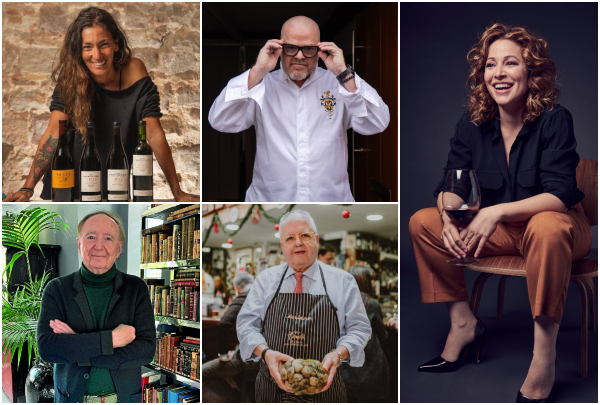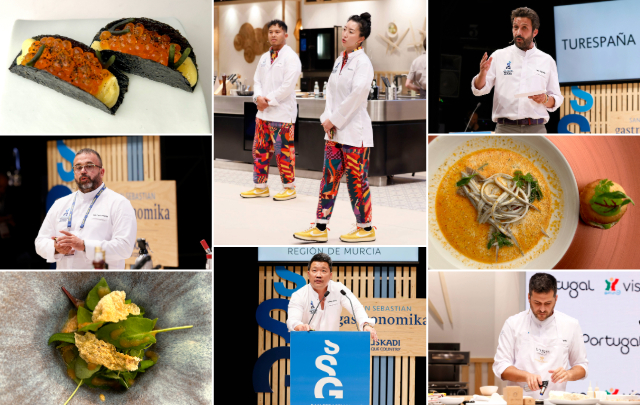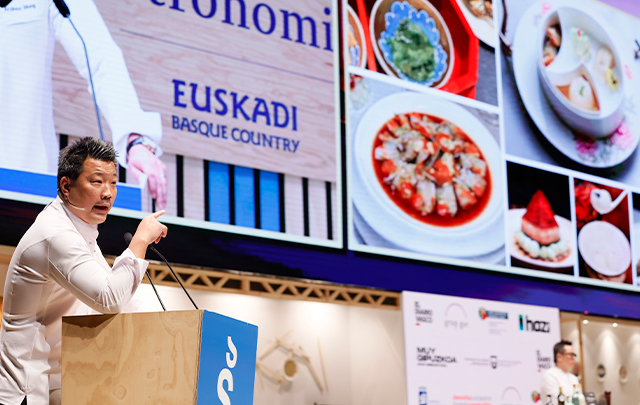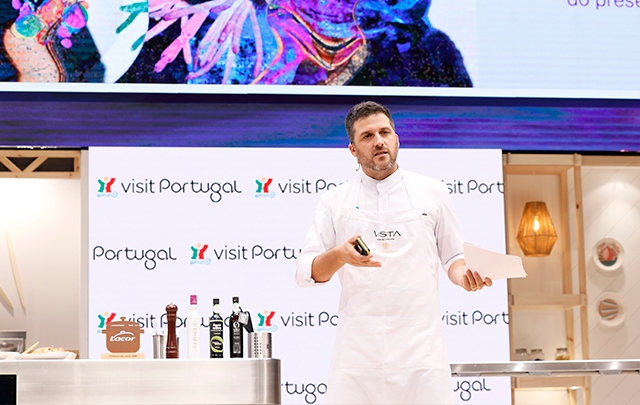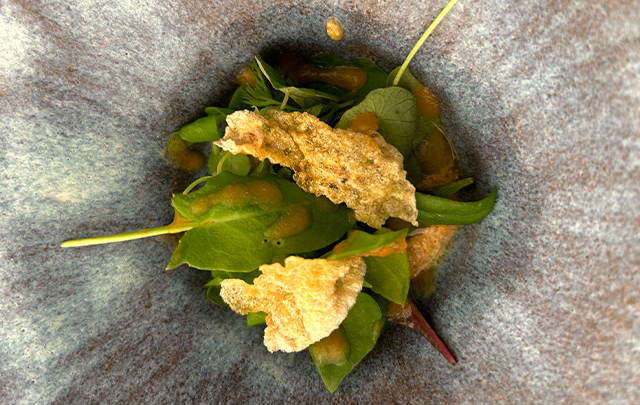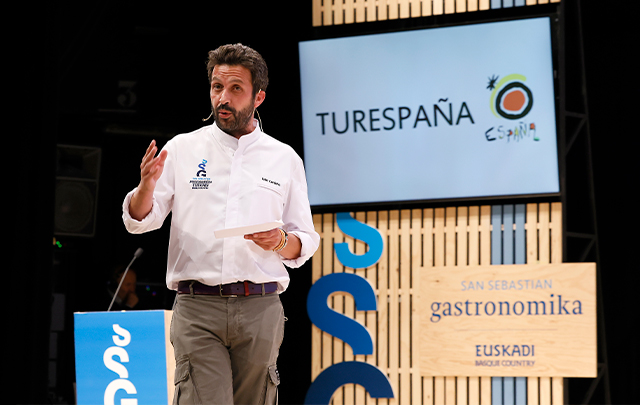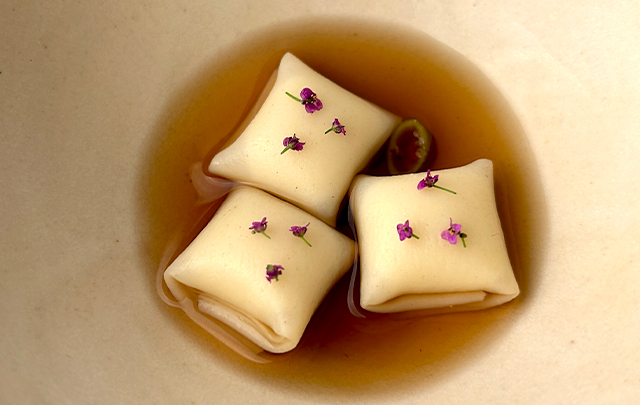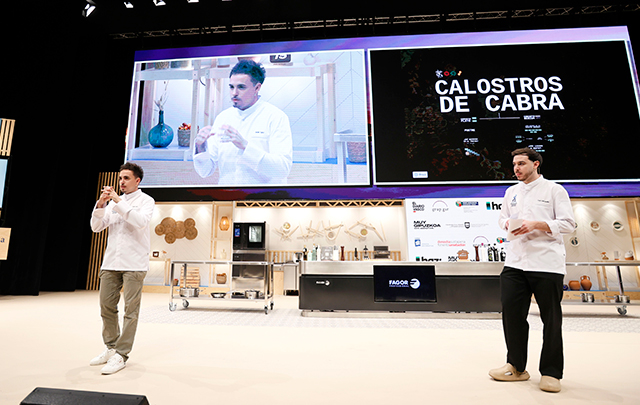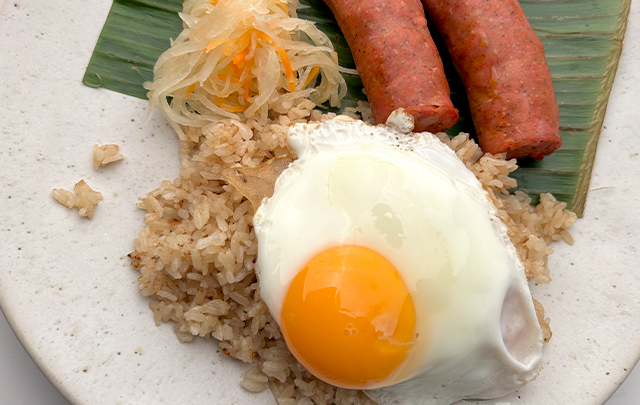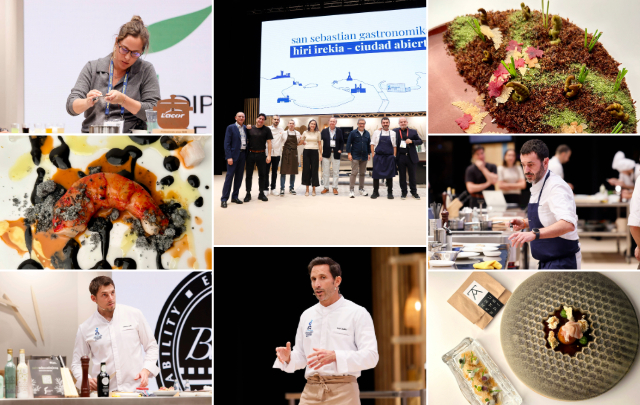News
Clamorous response to the 1st Tabernos and Taberneros Forum
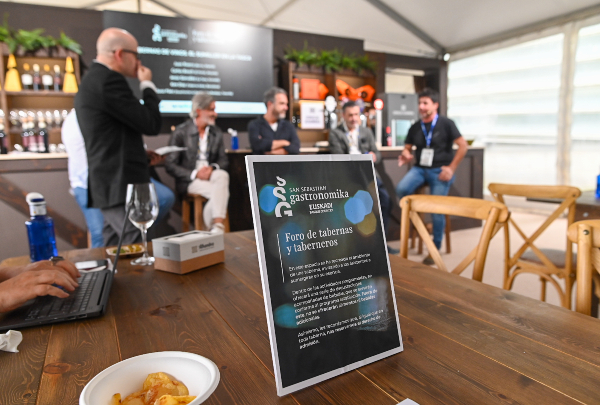
"It was long overdue for a gastronomy congress to deal with a sector that is the basis and the warmest, most inclusive and human side of gastronomy". These words from Sacha Hormaechea, rightly known as Tabernero Mayor, sum up the extraordinary reception of the 1st Forum of Taverns and Tavernkeepers, which began on Sunday 6th and ended on Tuesday 8th as a prologue to San Sebastian Gastronomika 2024. Hosted by the populariser, gastronome and (above all) tavern owner, Alberto Fernández Bombín, the forum brought together dozens of distinguished representatives of the oldest and most hospitable sector of gastronomy: that of bars. The venue, a large marquee set up on the terrace of the Kursaal and reminiscent of a tavern, was packed from start to finish.
The three days of the Tavern Forum were an opportunity to take a close look at the sector, admire its vitality, analyse its diversity and identify the challenges facing each type of tavern; to talk about the magic of a bar and the human relationships that are forged around it; and, of course, to enjoy tapas and drinks. Cervezas Alhambra and Bodegas Izadi were responsible for filling the glasses. There is always a risk in trying something new, but as Benjamín Lana, director of San Sebastian Gastronomika, points out, "although the congress was born in the world of haute cuisine, we want Gastronomika to be open to all forms of gastronomy. A Tavern Forum is something completely new and disruptive, but justified, because taverns are the seeds of contemporary hospitality'.
The Forum began on Sunday morning, filling the terrace of the Kursaal with the aroma of tripe, the quintessential preparation of tripe and taverns. The Pedro Martino World Tripe Championship chose this venue for its seventh edition, which was won by Áxel Smith from the Simpar restaurant in Santiago de Compostela, with a very fine and succulent Galician-style tripe. The jury stressed that the championship was of a very high standard. The competitors, after a preliminary selection made by the founder of the competition, Pedro Martino, were the Asturian Pepe Ron, from Bar Blanco, the Castilian Rubén Osorio, from Casa Mima (Miranda de Ebro), Pablo de Antonio Villoria (Origen, Salamanca); Juanjo Losada of the Pablo restaurant in Leon, Antonio del Álamo of Casa Felisa in Madrid, Mario Allende of the Grand Prix restaurant in Bilbao and, on the Mediterranean side, David Morea of Deliri (Barcelona) and Chemo Rausell of Napicol (Alquería de Roca, Valencia).
The Tabernas Forum was also the venue for a new competition: fish soups, another dish linked to traditional cuisine. In this case, the proposals submitted showed that the trend towards revising and updating traditional preparations has also reached the world of the spoon, sometimes even mixing the concepts of soup, cream and sauce. The president of the jury, Ramón Damián Fernández, head of markets at the Xunta de Galicia, which sponsors the competition and the forum, said: 'Soups are fundamental dishes in the kitchen that have been forgotten for too long, and the purpose of this competition is to rescue them from this oblivion and give them the leading role they deserve'. After a blind tasting, the winner was José Manuel Mallón of Remollo Espacio Gastronómico (A Coruña).
The championship offered a journey through the ways of understanding an essential seafood preparation: the Cantabrian style, with Manuel Doñelfa from Txoko de Getaria, Zuriñe García from the Hotel Puente Colgante in Portugalete, the Asturian Pucho Landín from the Real Balneario de Salinas, Fabian Feldmann from L'Impertinent in Biarritz (France) and the Cantabrian Jesús Gutiérrez from the Boga restaurant. The essences of the Mediterranean came from Joan Capilla (L'Algadir del Delta, Tarragona) and José Álvarez, from the La Costa restaurant (El Ejido), who offered an excellent Almerian soup with baby octopus. The Canary Islands were also represented by Víctor Suárez from the Haydée restaurant in Tenerife.
The theme of the forum was to identify the characteristics that distinguish bars from restaurants and other types of catering establishments. To this end, legendary bar owners were present, starting with Jorge Trifón of El Fogón de Trifón (Madrid); Mario Jiménez, the third-generation owner of El Faro (Cádiz); Xavier Zabaleta of the Aratz bar in San Sebastian; and Pepe Ron of Bar Blanco (Cangas del Narcea, Asturias). These four professionals revealed the secrets of the success of their establishments in the talk 'The men of the tavern': The love of the trade, according to Ron; a clear concept and the ability to transmit the main values of the establishment to the team, for Jiménez; the psychologist quality of the bartender and the orderliness of the work, according to Jorge Trifón; and making the customer feel good, for Zabaleta. Pepe Ron confessed that for him, the bar is his passion. Theoretically, I'm at the age where I start thinking about retiring, but all I think about is getting better,' he said.
Closeness, authenticity, empathy, trust, a refined concept, training the team so that they are clear about the concept and identity, were also aspects highlighted in the speech by Andoni Luis Aduriz (Mugaritz), Sacha Hormaechea (Sacha), Luis Suárez de Lezo, president of the Royal Academy of Gastronomy, and Benjamín Lana, who expressed the need to 'give taverns the respect and recognition that we gave haute cuisine 30 years ago'. Andoni Luis Aduriz said that 'the tavern is a reflection of the environment in which it is located. The essence of the tavern spirit is to be a meeting place and an inclusive space. Taverns are a refuge that allows people to slow down the fast pace of our lives. They are also spaces for observing life, true symbols of cities. Part of their success is that they combine two inescapable principles: identity and leadership. They are places because they build community.
But times change and you have to know how to adapt. The session 'The challenge of professionalising the tavern' brought together Carles Abellán (Tapas 24, Barcelona), Samuel Ruiz (Bar Verónicas, Murcia), Carlos Crespo (El Solórzano, Santander) and Pablo Loureiro of Casa Urola (San Sebastián). Taverns are very personalised businesses, where the owner, who is usually at the forefront, takes on the roles of restaurateur, manager and buyer. The key to development is to know how to surround yourself with people who can help you share these responsibilities,' says Abellán. Samuel Ruiz, owner of Bar Verónicas, is a chef who left the gastronomic restaurant format for that of a bar. I believe that the professionalisation of the bar should not only focus on the kitchen, but also on the human touch, because the first thing people look for in a bar is to feel welcomed and taken care of. Carlos Crespo and Pablo Loureiro raised the issue of staff motivation. A team needs to know what concept and philosophy they are selling, but they also need to be happy and motivated. Attention to work-life balance and allowing each person to do what he or she does best is fundamental," they said.
Today's taverns often include a sommelier. Their role in the bar was the subject of the session 'The sommelier in the tavern', which brought together Suso Pérez from Guachinche La Suertita (Tenerife), Juan Rivero from Berria (Madrid), Carlos Bosch (El Portal, Alicante); Jesús González from La Tana (Granada) and Kim Diaz from Taberna Soleá in Barcelona. Diaz pointed out that the tavern allows for the democratisation of wine, despite the fact that today's wine bars have significant investments in wine (La Tana, for example, has 1,700 references), glassware and professionals with specific training. In wine bars, wine is an investment. If you know how to manage it, you will make money; if you don't, it will ruin you,' said Carlos Bosch. Juan Rivero recalled the need for training that goes beyond tasting, oenology and service. The sommelier must not only know about wines, but also know how to get down to the level of the customer, because his mission is to sell".
Monday's session closed with a talk on 'The recovery of traditional bars', which brought together Manuel Urbano, who, after his success in Madrid with La Malaje, opened El Campillo in the El Rastro district, a traditional bar offering beers for two euros with an aperitif and coffee in a glass; Ming Heng Chen, who took over the traditional Bar Delfín from its previous owner, Afrodisio Dios, alias 'Paco', on the condition that he teach him cooking and even Castilian jokes, and today boasts his Callos a la Madrileña and other traditional tapas. Eduardo Camiña (Taberna Lagüiña Lieux-dit, Pontevedra), an award-winning sommelier who left Mugaritz to take over his mother's bar in Pontevedra, has also stepped in, betting on a wine bar with a simple menu of food and tapas. A demonstration that bars are a reflection of their society and their times, and that, as Urbano said, "something has to change so that nothing changes".
The third and final day, Tuesday the 8th, focused on analysing the reality and challenges of different types of bars. The product establishments were represented by Paco Martín, from the FM bar in Granada; César Álvarez, from A Fuchela, Temple of the Galician Octopus in O Carballiño, and Carlos Castelló, from Piripi, Alicante. In these bars, based on the excellence of the raw material, the concern is focused on the increase in the price of products such as seafood and fish, and the problem of shortages caused by this price increase. The moderator and master of ceremonies of the forum, Alberto Fernández Bombín, suggested the possibility of opening up to new products. You can no longer live on a single dish," admitted César Álvarez. Variety is strength," he added.
Gastronomic taverns, or 'neo-taverns', were also discussed. The format was analysed by Ricard Camarena, representing his Bar X (Valencia); José Álvarez, of La Barra de José Álvarez (El Ejido); Nacho Solana, of La Solana restaurant and La Bien Aparecida bar in Ampuero (Cantabria); and Gorka Txapartegi, of Alameda restaurant and Taberna del Alameda. In all cases, the chefs are combining Michelin-starred restaurants with more popular formats that allow them to "keep in touch with the local public", as Solana puts it; "offer quality but more affordable and fun bites", according to José Álvarez; or "satisfy a clientele that would not be associated with gastronomy", in the words of Txapartegi.
There are bars and taverns that are part of the city's cultural heritage, just like its historic buildings and monuments. These were analysed in the presentation 'Tavern tourism', the challenge of which is to 'continue to satisfy the traditional clientele and welcome tourists and visitors', according to Miguel Cabezas, owner of Casa Pepe de la Judería (Cordoba). 'I go to Cordoba and I go to the mosque, but I also want to go to Casa Pepe', said the Tenerife journalist Francisco Belín, who was in charge of moderating this round table. The identity of the tascas is very important, the relationship that is created between the customer and the tasquero, that is the most important thing,' says Pepe Torres, owner of Bodegas Castañeda, an institution in Granada opened in 1927. We have lived with tourism for many years. We welcome the lifelong parishioner who comes to drink his vermouth and, logically, the tourist, and the two audiences mix very well,' he said.
There are taverns that reach great gastronomic heights without having a kitchen. Great exponents of 'cooking without fire', such as Enrique and Carlos Valentí (Hermanos Vinagre, Madrid), Joaquim Pérez Sanz (Quimet, Barcelona) and Javier Cabrera, from Astrolabio (Valladolid), talked about the advantages and disadvantages of bars that base their gastronomic offer on preserves, sausages, cheeses, pickles and raw products. In principle, it may seem easier to do what we do, but not having a fire forces you to think about everything much more,' said Javier Cabrera. For Joaquim Pérez Sanz, 'ours is a kind of solid cocktail bar. We have a bar and we make combinations of prepared ingredients'. To do what we do, you need chefs, of course", added the Valentí brothers, who, like their companions, are chefs with careers in conventional restaurants. In any case,' they add, 'people don't come to bars for the food, they come to have fun.
Sacha Hormaechea, Juanjo López, from La Tasquita (Madrid), Pepe Solla, from Casa Solla, and Edorta Lamo, from Arrea!, concluded the day by talking about 'restaurants with a tavern soul'. They agreed that the human aspect and the desire for direct communication with the customer is what defines this type of business. Sacha Hormaechea invited the many bar and tavern owners who filled the room to speak, and the conversation on the last day of the Forum ended with an emotional, heartfelt and nostalgic love song to bars: "Places disappear because we stop going there. If we feel that these places are part of us, we have to support them,' asked Hormaechea. Juanjo López also called for the institutions to be supported with administrative measures to help them survive.
In addition to this intense and wide-ranging debate on the identity, values and future of bars, other aspects were analysed, such as that of the writer and restaurateur Andrés Sánchez Magro, who explored 'El ADN del Parroquiano' (The DNA of the Parroquiano). The author of 'Lo castizo en el siglo XXI' and 'Tabernas de Madrid' said: 'The parroquiano is the character who is part of a family in the bar'. In the same vein, Sacha Hormaechea said in his dedication after being appointed Mayor of Tabernas: 'This award is dedicated to all those people whose lives are supported by a bar'.
The history of taverns and the history of tripe were other complementary themes that fell to two great specialists. The sommelier Ferran Centelles went back to ancient Rome and travelled to post-revolutionary France to find the references from which today's taverns drink, and accompanied his talk with a curious tasting of tavern drinks such as piquet, a soft drink made in the past from the skins, seeds and leftovers from wine fermentation. These drinks were accompanied by a meat stew made from the oldest documented recipe for tavern food, an English cookbook.
The journalist, historian and winner of the National Gastronomy Prize, Ana Vega Pérez de Arlucea, always brilliant and amusing, explained the history of tripe and its name. In Galician, callo means rennet, a word used to describe the fourth stomach of the ruminant, which is the curd,' she said. Tripe is mentioned under this name in 1593 by Guzmán de Alfarache and in Covarrubias' dictionary of 1611. Even then it was said that tripe was a tasty snack for uncouth people,' he said. In addition to the history, three great connoisseurs of the dish defined the keys to good tripe. Pedro Martino, creator of the World Championship, recalled the importance of the proportions of tripe, leg and snout to achieve tenderness. Jorge Trifón, from 'El fogón de trifón', insisted on the importance of cleanliness, respect for textures when cooking and seasoning. Callo is not hospital food; the spicy touch is important, although always controlled,' said the researcher and writer Antonio Martín Chaler, author of 'La vuelta España en ochenta callos', who recalled that stew was originally the way to make the most of the whole animal. Tripe was food for the poor in Spain and slaves in America. It was the offal that was worthless, and cuisine has managed to revalue it,' he said.
Focusing on traditional, affordable and succulent dishes, highlighting the condition of welcoming and inclusive spaces where people of different types and origins mix, analysing the keys to survival in times of change and, above all, giving the floor to the professionals who not only form the basis of the restaurant industry but also guard the essence of the trade, the 1st Taverns and Tavernkeepers Forum debuted with a success that announces that its journey has only just begun.

